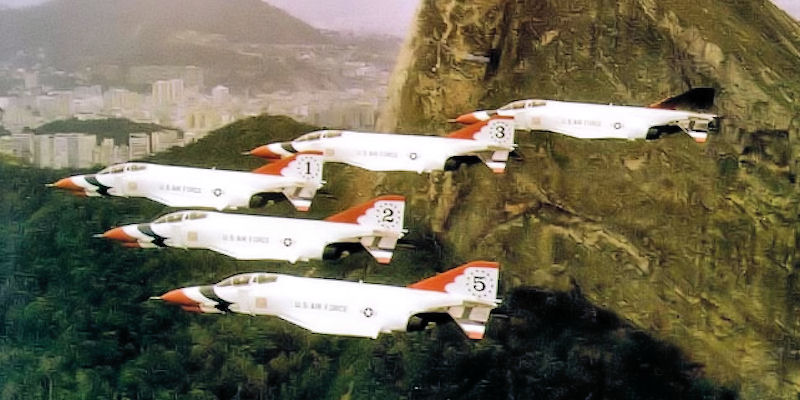Recently, I had the very good fortune to make a pilgrimage with my good friend Dr. John Daley to Monett, Missouri to visit an F-4 Phantom displayed on a pylon. A number of ex-military aircraft are displayed in Thunderbirds...
Recently, I had the very good fortune to make a pilgrimage with my good friend Dr. John Daley to Monett, Missouri to visit an F-4 Phantom displayed on a pylon. A number of ex-military aircraft are displayed in Thunderbirds livery, but unusually, this machine is a genuine veteran of the USAF display team.
 Still looking sleek in the Missouri sunshine, June 2023. 66-0315 is a McDonnell F-4E-32-MC Phantom with the Manufacturers’ Serial Number (MSN) 2358. It was mounted on its pylon in 1995, (Photo: Robert Smith – own work)
Still looking sleek in the Missouri sunshine, June 2023. 66-0315 is a McDonnell F-4E-32-MC Phantom with the Manufacturers’ Serial Number (MSN) 2358. It was mounted on its pylon in 1995, (Photo: Robert Smith – own work)
Thanks to the indispensable efforts of Joe Baugher, I can report that 66-0315 is a McDonnell F-4E-32-MC Phantom with the Manufacturers’ Serial Number (MSN) 2358. She emerged from the McDonnell factory in St. Louis, MO in November 1967 and started her USAF service with the 33rd Tactical Fighter Wing (TFW) at Eglin AFB, Florida. 33TFW’s activities at the time included tactical training, weapon systems testing, and F-4 replacement training. Fresh aircraft and aircrews were sent from Eglin to Southeast Asia and Korea.
 The pilgrims. I’m on the left in the blue shirt. That’s Dr. John Daley next to me checking out the selfie in the bright sunshine. Behind us, F-4E 66-0315. That’s the Monett YMCA in the background, I think. (Photo: Robert Smith – own work)
The pilgrims. I’m on the left in the blue shirt. That’s Dr. John Daley next to me checking out the selfie in the bright sunshine. Behind us, F-4E 66-0315. That’s the Monett YMCA in the background, I think. (Photo: Robert Smith – own work)
 The aircraft is in surprisingly good condition considering it’s been on a pylon for 28 years. (Photo: Robert Smith – own work)
The aircraft is in surprisingly good condition considering it’s been on a pylon for 28 years. (Photo: Robert Smith – own work)
In early 1969 66-0315 returned home to St. Louis to be prepared for her next assignment to the USAF Display Team. This work entailed the removal of radar and weapons systems and the addition of a smoke generator. 0315 served with the team from 1969 and was photographed by enthusiasts and spotters in the livery of Thunderbird 3 or Thunderbird 5 at different locations in the USA and abroad. Following the 1973 oil crisis, the F-4 was deemed to be a gas guzzler and the Thunderbirds switched to the more economical T-38.
 It is documented that 66-0315 flew as number 3 and number 5 while with the Thunderbirds, so she *might* be in this picture! United States Air Force photo of the Thunderbirds demonstration team in 1972 (USAF, Public Domain, via Wikimedia Commons)
It is documented that 66-0315 flew as number 3 and number 5 while with the Thunderbirds, so she *might* be in this picture! United States Air Force photo of the Thunderbirds demonstration team in 1972 (USAF, Public Domain, via Wikimedia Commons)
66-0315 and the other F-4s were returned to regular duty in early 1974. There remained the question of what that duty might be, since a weaponless and radar-less Phantom was not suitable for regular squadron service. The former Thunderbirds machines were assigned to (or acquired by) 6512 Test Squadron, at the Air Force Flight Test Center (AFFTC – later AFTC) at Edwards AFB in California, which operated a mixed fleet of F-4s until 1990.
Several of the F-4s at Edwards were finished in an interesting color scheme in which the fuselage bore standard USAF camouflage but the wings were painted white. At first I thought this was a throwback to 0315’s days with the Thunderbirds, but it seems that all the NF-4s conducting chase missions during the testing of the AGM-86 Air Launched Cruise Missile (ALCM) were painted this way to improve visibility. Sometime in the mid 80s the fleet was painted white again.
I can’t find a usable pic of 0315 but here is a sister ship. Former Thunderbird – now NF-4E 60-0286 at Edwards AFB, 22 January 1987. 66-0286 is preserved in the Veterans Park in Hamilton, New Jersey seemingly still in its Edwards color scheme. Photo by Rob Schlieffert on Flickr – Attribution-NonCommercial-NoDerivs 2.0 Generic (CC BY-NC-ND 2.0)Joe Baugher records that 0315’s next step was to MASDC (Military Aircraft Storage and Disposition Center) in Arizona in 1991. From here her next step might have conceivably been to the scrapyard but fate intervened.
I can’t say I’ve conducted any research as to how she got to Monett. As far as I understand 66-0315 was delivered in pieces by the USAF and re-assembled in situ in 1995. I would love to see pictures of the assembly just to see what residual paint job she had at that time. She has been been used as a convenient perch by many of the local birds with the obvious deleterious effects on the paint job, but in general it’s in better condition than some of the display machines I’ve seen around the United States.



